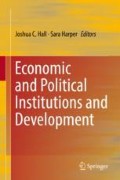Abstract
Overcoming the limited access to formal financial services continues to be one of the most challenging tasks facing many developing countries. Recently, it has been argued by some authors that the rise in personal remittance inflows to these countries could be leveraged for more inclusive finance. In this essay, we examine whether remittances have provided additional avenues for policymakers to promote financial inclusion. Although some case studies have explored the potential link between remittances and households’ demand for financial services, no cross-country analysis has yet been carried out for empirical tests. We use data from the World Bank Global Findex database (Demirguc-Kunt et al., The Global Findex Database 2011: measuring financial inclusion and the Fintech revolution. The World Bank, Washington, 2011) on financial inclusion for 107 remittance-receiving countries to examine whether remittances contribute to inclusive finance. Contrary to the findings from earlier case studies, our results show that remittance inflows have a significant negative impact on financial inclusion by reducing the demand for deposit accounts from formal financial institutions. However, our results are consistent with the earlier findings that remittances do not have a significant and robust impact on the demand for credit instruments from formal institutions. These results continue to hold when the data are disaggregated for the rural sector. More importantly, the partial effects of remittances are found to be non-linear across countries.
Access this chapter
Tax calculation will be finalised at checkout
Purchases are for personal use only
References
2016 HDR (2016) Human Development for Everyone. United Nations Publications, Washington DC
Abdih Y, Chami R, Dagher J, Montiel P (2012) Remittances and institutions: Are remittances a curse? World Development 40(4):657–666
Adams Jr RH, Page J (2005) Do international migration and remittances reduce poverty in developing countries? World Development 33(10):1645–1669
Aggarwal R, Demirguc-Kunt A, Peria MSM (2011) Do remittances promote financial development? Journal of Development Economics 96(2):255–264
Anzoategui D, Demirguc-Kunt A, Peria MSM (2014) Remittances and financial inclusion: Evidence from El Salvador. World Development (54):338–349
Ashraf N, Aycinena D, Martinez C, Yang D (2010) Remittances and the problem of control: A field experiment among migrants from El Salvador
Center for Financial Inclusion (2017) Center for Financial Inclusion. Center for Financial Inclusion, Washington, DC
Conroy JD (2008) Financial inclusion: A new microfinance initiative for APEC. The Foundation for Development Cooperation
Cooray A (2012) Migrant remittances, financial sector development and the government ownership of banks: Evidence from a group of non-OECD economies. Journal of International Financial Markets, Institutions and Money 22(4):936–957
De Koker L, Jentzsch N (2013) Financial inclusion and financial integrity: Aligned incentives? World Development 44:267–280
Demirguc-Kunt A, Klapper L (2013) Measuring financial inclusion: Explaining variation in use of financial services across and within countries. Brookings Papers on Economic Activity 2013(1):279–340
Demirguc-Kunt A, Klapper L, Singer D, Ansar S, Hess J (2011) The Global Findex Database 2011: Measuring Financial Inclusion and the Fintech Revolution. The World Bank, Washington DC
Duflo E, Banerjee A, Glennerster R, Kinnan CG (2010) The miracle of microfinance? Evidence from a randomized evaluation. Boston
Dupas P, Robinson J (2009) Savings Constraints and Microenterprise Development: Evidence from a Field Experiment in Kenya. Boston
Fund UNCD (2006) Building inclusive financial sectors for development. United Nations Publications, Washington DC
Fungáčová Z, Weill L (2014) Understanding financial inclusion in China. China Economic Review 34:196–206
Giuliano P, Ruiz-Arranz M (2009) Remittances, financial development, and growth. Journal of Development Economics 90(1):144–152
Gupta S, Pattillo CA, Wagh S (2009) Effect of remittances on poverty and financial development in sub-Saharan Africa. World Development 37(1):104–115
Karlan D, Zinman J (2010) Expanding credit access: Using randomized supply decisions to estimate the impacts. Review of Financial Studies 23(1):433–464
Li Q, Racine JS (2007) Nonparametric econometrics: theory and practice. Princeton University Press
Lopez H, Fajnzylber P, Calderon C, Acosta P (2007) What is the impact of international remittances on poverty and inequality in Latin America? The World Bank
Racine JS (2009) Nonparametric and semiparametric methods in r. In: Nonparametric Econometric Methods, Emerald Group Publishing Limited, pp 335–375
Rempel H, Lobdell RA (1978) The role of urban-to-rural remittances in rural development. The Journal of Development Studies 14(3):324–341
Robinson PM (1988) Root-n-consistent semiparametric regression. Econometrica: Journal of the Econometric Society 56(4):931–954
Vlcek W (2006) Development v. Terrorism-migrant remittances or terrorist financing. Institute of Commonwealth Studies, London
World Bank (2011) World Development Indicators. World Bank, Washington DC
World Bank (2013) Projects and Operations. World Bank, Washington DC
World Bank (2017) The Global Findex database 2017. World Bank, Washington DC
Yang D (2005) International migration, human capital, and entrepreneurship: evidence from Philippine migrants’ exchange rate shocks. Mimeo, Michigan
Author information
Authors and Affiliations
Editor information
Editors and Affiliations
Rights and permissions
Copyright information
© 2019 Springer Nature Switzerland AG
About this chapter
Cite this chapter
Gautam, D.P. (2019). Do Remittances Promote Financial Inclusion?. In: Hall, J., Harper, S. (eds) Economic and Political Institutions and Development. Springer, Cham. https://doi.org/10.1007/978-3-030-06049-7_6
Download citation
DOI: https://doi.org/10.1007/978-3-030-06049-7_6
Published:
Publisher Name: Springer, Cham
Print ISBN: 978-3-030-06048-0
Online ISBN: 978-3-030-06049-7
eBook Packages: Economics and FinanceEconomics and Finance (R0)

